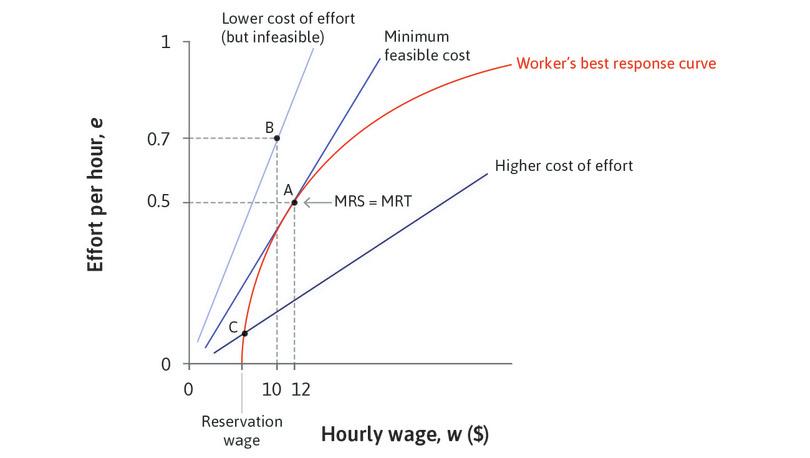Leibniz
6.7.1 Profit, wages, and effort
In the interaction between Maria and her employer, the employer chooses the wage, and the worker responds by choosing how hard to work. In this Leibniz we analyse the employer’s wage-setting decision mathematically.
How should Maria’s employer choose the wage? We will show first that, in order to maximize profit, he should choose the wage that minimizes the cost per unit of effort, taking into account how Maria will respond.
If the firm employs Maria for hours per week and her effort is , she does hours of productive work, where . Suppose the employer’s production function is , and the output produced can be sold at a price . Then the employer’s profits, which we denote using the upper-case form of the Greek letter ‘pi’, , can be written as:
The employer is free to choose the wage, and also the number of hours for which Maria is employed; Maria will choose her own effort. So the employer would like to choose and to maximize , knowing that whatever wage is chosen, Maria will respond by choosing:
Thinking about this problem, it is not obvious that the employer should choose the wage that minimizes the cost of effort, —although we argued in the text that he should do so. To see it mathematically, it is helpful to rewrite the profits in terms of and , rather than and (remember that is the input to production). Substituting gives us:
We can now see that profit depends on the number of units of work, , and the cost per unit of work (or effort), . It is clear from this expression that to maximize profit, the employer should set the wage so that the cost is as low as possible.
Choosing the wage
We have shown that the employer should choose the wage to minimize the cost per unit of effort , taking into account that Maria will choose . By the quotient rule:
We obtain the first-order condition for cost-minimization by setting this expression equal to zero. So the cost-minimizing wage satisfies the equation:
In the alternative notation for derivatives, the equation may be written as:
This condition for the wage is illustrated in Figure 1, which reproduces Figure 6.6 of the text. The straight lines are the isocost lines for effort, which have slope . At point A, the equation above is satisfied: the slope of the isocost line, , is equal to the slope of the worker’s best response curve, . For the best response curve shown in this diagram, , and the corresponding level of effort is = 0.5.
In the diagram, the steeper isocost lines correspond to lower costs per unit of effort (higher , lower ). So we can see that point A is the cost-minimizing point on the best-response curve. To check mathematically that the wage satisfying the first-order condition, , corresponds to a minimum point of the function , we should work out the second derivative and check that it is positive when . If you do this, you will find that the concave shape of the best response curve, expressed mathematically by the condition , guarantees that minimizes the cost.
Choosing hours of work
Having determined the profit-maximizing and cost-minimizing wage, , the employer can decide how many units of work effort, , are needed to maximize profits. If the wage is set equal to , profits are:
Differentiating with respect to and setting the derivative to zero gives us an equation for the profit-maximizing input :
This equation has an economic interpretation. is the marginal product of an additional unit of work effort, and so is the marginal revenue that the employer obtains from a unit of work effort. The employer maximizes profits by choosing so that the marginal revenue is equal to the marginal cost of an additional unit, .
Finally, having found the optimal number of units of work effort, , and knowing that Maria will choose an effort level of , he can find the number of hours for which he should employ her from the relationship .
An example
Suppose that Maria’s reservation wage is (a positive constant) and her best response function is:
where and are also positive constants, with . Then the first-order condition for the profit-maximizing wage, , is:
Dividing by the right-hand side gives us , and hence:
Notice that depends on and but not on . The numbers in Figure 1 correspond to the case where , and .
The employer will set , and Maria will choose her level of effort in response:
Read more: Sections 7.1 and 8.1 of Malcolm Pemberton and Nicholas Rau. 2015. Mathematics for economists: An introductory textbook, 4th ed. Manchester: Manchester University Press.

